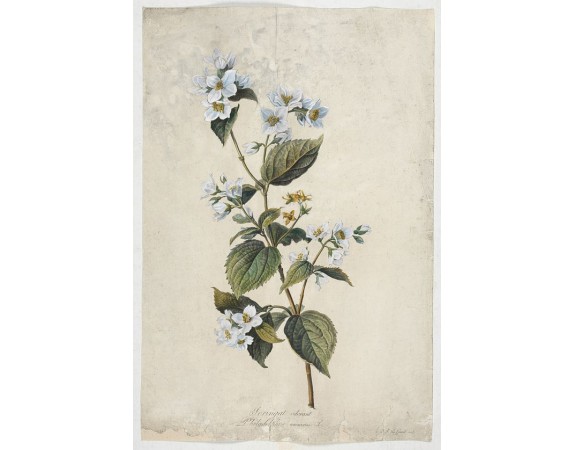SPAENDONCK, G. van - Seringat odorant. Philadelphus coronarius. L.
 cliquez sur l'image pour l'agrandir
cliquez sur l'image pour l'agrandir

SPAENDONCK, G. van - Seringat odorant. Philadelphus coronarius. L.
Date: Paris, ca. 1800
Format: 460 x 300 mm.
Color: Col.
Condition: On white woven paper with heavy dust marks affecting printed area. Frayed bottom margin affecting printed title. Also torn upper right margin. Else a good and dark impression. Paper size 480 x 330mm.
Description
Bouquet of Seringats. Engraved by Le Grand, P.F.
Gerard van Spaendonck (1746-1822) Painter and printmaker. In 1764 he was apprenticed to the decorative painter Guillaume-Jacques Herreyns, in Antwerp. In 1769, Gerard left for Paris and, having been appointed miniature painter to the newly crowned Louis XVI in 1774, he became a candidate for membership of the Académie Royale the following year, making his Salon début in 1777. In 1780, he succeeded Madeleine Basseporte (1701–80) as professor of flower painting at the Jardin des Plantes. In 1781 he was elected a member of the Académie and began contributing to the Vélins du Roi, a series of botanical studies painted on vellum. Gerard eventually contributed over 50 such studies (e.g. Hibiscus Flower , 1785; Paris, Mus. N. Hist. Nat.) and in doing so changed from the traditional medium of gouache to watercolour. The task and the medium were assumed by his famous pupil, Pierre-Joseph Redouté. Van Spaendonck exhibited two of these flower studies on vellum together with five oils at the Salon of 1783 and was highly praised by the critics. At this period he was also active designing for the Sèvres porcelain factory.
Gerard van Spaendonck (1746-1822) Painter and printmaker. In 1764 he was apprenticed to the decorative painter Guillaume-Jacques Herreyns, in Antwerp. In 1769, Gerard left for Paris and, having been appointed miniature painter to the newly crowned Louis XVI in 1774, he became a candidate for membership of the Académie Royale the following year, making his Salon début in 1777. In 1780, he succeeded Madeleine Basseporte (1701–80) as professor of flower painting at the Jardin des Plantes. In 1781 he was elected a member of the Académie and began contributing to the Vélins du Roi, a series of botanical studies painted on vellum. Gerard eventually contributed over 50 such studies (e.g. Hibiscus Flower , 1785; Paris, Mus. N. Hist. Nat.) and in doing so changed from the traditional medium of gouache to watercolour. The task and the medium were assumed by his famous pupil, Pierre-Joseph Redouté. Van Spaendonck exhibited two of these flower studies on vellum together with five oils at the Salon of 1783 and was highly praised by the critics. At this period he was also active designing for the Sèvres porcelain factory.
350€
- N° Reference: 27742
